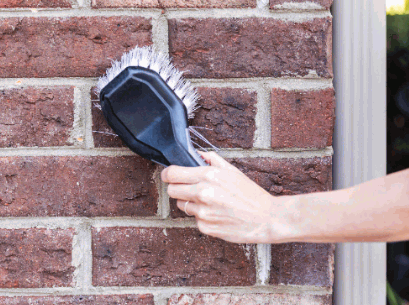Table of Contents
Soot build-up on bricks can be an unsightly and frustrating problem for homeowners. Whether it’s from a fireplace, grill, or outdoor fire pit, the dark residue can tarnish the beauty of your brick surfaces. This issue is exacerbated by smoke and heat, contributing to more stubborn stains.
This article explores the causes of soot accumulation and provides the tools and materials needed for effective cleaning. It also guides you through essential safety precautions and preparation steps, followed by various cleaning methods, ensuring your bricks look their best once again. The methods discussed include professional techniques and home remedies using common household cleaners.
Additionally, learn how to maintain their cleanliness and prevent future build-up, helping you keep your home looking pristine. Regular maintenance and care can significantly reduce the risk of damage to your brick surfaces.
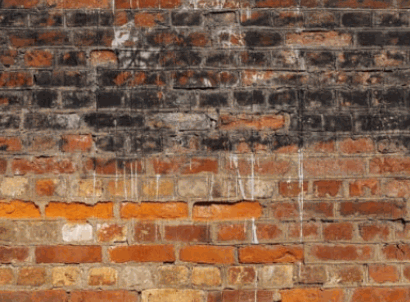
What Causes Soot Build-Up On Bricks?
Soot build-up on bricks primarily results from the combustion of wood and other materials in a fireplace, where carbon and other particles are released into the air during the burning process. Over time, these particles settle on the porous surface of the bricks, leading to dark stains and a reduction in the overall cleanliness of your home.
Factors such as inadequate ventilation, using poor-quality firewood, or a poorly maintained fireplace can exacerbate the soot accumulation, making it essential for homeowners to understand the causes and take proactive measures to prevent this issue.
Take a look: Can You Clean With Baking Powder

What Tools And Materials Do You Need To Clean Soot Off Bricks?
To effectively clean soot off bricks, you will need a variety of tools and materials that are both effective and safe for your cleaning process. Essential items include sponges, a stiff-bristled brush, and a selection of cleaning solutions such as a mixture of water and vinegar, dish soap, baking soda, and even Trisodium phosphate for tougher stains. These materials, including abrasive cleaners and eco-friendly options, ensure a comprehensive approach to soot removal.
Choosing the right tools will help ensure that you maintain the integrity of the brick surface while achieving optimal cleanliness in your fireplace area. Below is a list of necessary items that will assist in this endeavour:
- Sponges: Ideal for gentle cleaning without scratching the brick surface. They absorb grime effectively.
- Stiff-bristled brush: Perfect for scrubbing away stubborn soot while being tough on stains yet gentle on the bricks.
- Water and vinegar solution: An eco-friendly option for cutting through residue.
- Washing-up liquid: Works wonders for light cleaning and rejuvenating the surface.
- Baking soda: A natural abrasive that helps lift grime and neutralises odours.
- Trisodium phosphate: A powerful cleaner for those particularly difficult stains.
Using these tools and materials not only ensures that you remove soot effectively but also preserves the appearance and longevity of your brickwork. Implementing these cleaning techniques will protect your home from ongoing soot damage.
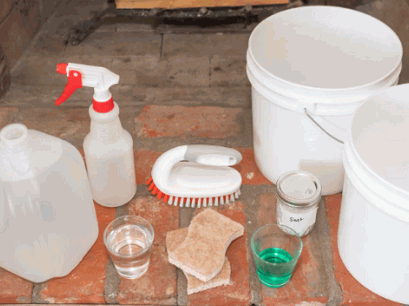
What Are The Safety Precautions To Take Before Cleaning?
Before beginning the cleaning process for soot-off bricks, it’s crucial to take essential safety precautions to protect yourself and your home. This includes wearing protective gear such as gloves, masks, and goggles to prevent inhaling soot particles or coming into contact with cleaning solutions. Ensure that the area is well-ventilated and that flammable materials are kept away from the cleaning site to reduce the risk of fire hazards. It’s important to choose appropriate cleaning materials that won’t damage the porous brick surface.
Proper preparation goes a long way toward ensuring a safe and efficient cleaning experience. When tackling the problem of soot on bricks, it’s essential not only to consider the correct cleaning methods but also to adhere strictly to safety measures. Using acids or other harsh substances should be approached with caution to prevent unwanted damage.
Here are some vital precautions:
- Ventilation: Open windows and doors to allow fresh air circulation, which helps to dissipate harmful fumes.
- Protective Clothing: Wear long sleeves, long trousers, and sturdy footwear. This minimises skin exposure to both soot and cleaning agents.
- Chemical Handling: Always read label instructions carefully when using cleaning solutions. Store these chemicals in a secure place and ensure that lids are tightly closed after use.
By prioritising these safety measures, you not only protect yourself but also set the stage for a more effective cleaning session.
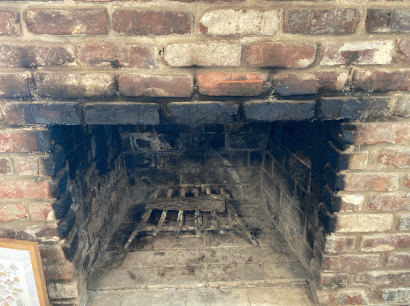
How To Prepare For Cleaning Soot Off Bricks?
Preparing to clean soot off bricks involves several important steps that will set the stage for effective and safe cleaning.
Start by assessing the extent of soot build-up and gathering all necessary tools and materials. Clear the area around the fireplace to avoid damaging surrounding items, and ensure you have protective gear and adequate ventilation. Consider using a paste made from baking soda and water as a preliminary step. These preparation steps will not only make the cleaning process smoother but also enhance the effectiveness of your chosen cleaning methods.
What Are The Steps For Preparing The Brick Surface?
Preparing the brick surface for cleaning soot is a critical step that ensures the successful removal of stains and dirt. Effective surface preparation not only facilitates the overall cleaning process but also preserves the integrity of the brick. Begin by gently brushing off any loose soot or debris with a soft-bristle brush, taking care to avoid scratching the surface. Next, dampen the brick with water to help loosen the soot particles before applying your chosen cleaning solution, such as a vinegar and salt mix. This initial preparation will enhance the effectiveness of your cleaning techniques and contribute to the cleanliness of your fireplace.
Once you have dampened the brick, consider utilising a specific cleaning agent that is suitable for masonry. Choose from dish soap, baking soda, or commercial cleaners depending on the level of staining. Here are some key steps to continue:
- Choose the Right Cleaner: Select a cleaner specifically formulated for brick surfaces to ensure it is gentle yet effective.
- Test a Small Area: Always test your cleaning solution on a small, inconspicuous area to avoid discolouration or damage.
- Apply the Cleaner: Use a sponge or soft cloth to apply the cleaning solution, letting it sit for a few minutes to penetrate the soot.
- Scrub Gently: With a soft-bristle brush, scrub the area gently to lift the stains without damaging the brick.
- Rinse Thoroughly: Rinse the area with clean water to remove all cleaning residue, ensuring the brick is left in pristine condition.
By following these techniques, the effectiveness of your cleaning efforts will significantly increase, leading to a more polished and clean brick surface.
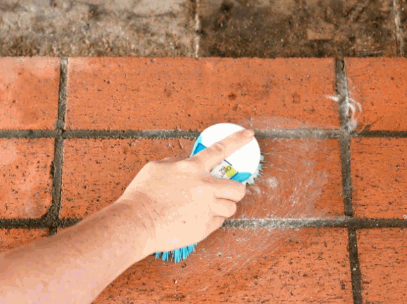
What Are The Steps For Protecting Surrounding Areas?
To ensure that the cleaning process goes smoothly, it is essential to take steps to protect the surrounding areas of your fireplace from soot and cleaning solutions. Start by laying down a waterproof dustsheet to catch any falling soot or drips from your cleaning products. Remove any nearby furniture or items that could be damaged during the cleaning process. Protecting the area is critical, particularly when using strong cleaners or abrasive tools. These precautions will help maintain the cleanliness and integrity of your home while working on your fireplace.
By implementing these protective measures, one can significantly reduce potential mess and damage.
- Consider using decorators’ tape to secure the edges of the dustsheet and to protect skirting boards or trim.
- Wrap any valuable or delicate items in soft cloths and move them to a safe location far from the cleaning area.
- Install a temporary barrier, such as a screen or gate, to limit access to the cleaning zone for pets and children.
These simple strategies not only help keep the area tidy but also ensure that your belongings remain undisturbed and intact during the cleaning process.
What Are The Different Methods For Cleaning Soot Off Bricks?
There are several effective methods for cleaning soot off bricks, each offering unique advantages depending on the severity of the stains and the materials involved.
Homeowners can choose from methods such as:
- using a pressure washer for heavy-duty cleaning,
- employing a scrubbing brush with detergent for more controlled scrubbing,
- utilising specific chemical cleaners designed for soot removal,
- or opting for a dry cleaning sponge that can absorb soot without the need for additional solutions.
Some methods use micro-abrasives for effective stain removal. Understanding these methods will help homeowners select the best approach for their specific needs.
Using A Pressure Washer
Using a pressure washer is one of the most efficient techniques for cleaning soot off bricks, particularly for heavy build-up and outdoor surfaces. This method involves directing a high-pressure stream of water onto the sooted areas, effectively dislodging soot and stains while minimising the need for excessive scrubbing. It’s crucial to use the appropriate pressure settings to avoid damaging the porous brick material during the cleaning process. This technique is ideal for homeowners looking to tackle tough stains effectively.
To achieve optimal results, it is essential to adjust the pressure washer’s settings based on the surface type and the extent of the soot accumulation. For instance, a lower pressure setting of around 1500 PSI is often suitable for delicate brickwork, while a stronger pressure of up to 3000 PSI may be necessary for tougher, more resistant stains.
Alongside adjusting the pressure, employing a wide-angle nozzle can help distribute the water more evenly across the surface, minimising the likelihood of causing damage.
- Techniques for Effective Use:
- Begin by soaking the area to loosen the soot.
- Work from the top down to prevent streaks.
- Maintain a consistent distance from the surface, typically around 12 to 18 inches.
Using a pressure washer not only saves time but also reduces the use of harsh chemicals, making it an eco-friendly option for maintaining the aesthetic appeal of brick surfaces.

Using A Scrub Brush And Detergent
Recommended by cleaning experts, the use of scrub brushes and detergents is a tried and true method for removing soot without harming the environment.
Using a scrubbing brush along with a detergent solution is a classic and effective method for cleaning soot off bricks. This powerful technique not only restores the natural beauty of the bricks but ensures that any lingering residues or stains are eliminated in the process.
To begin, gather the following materials:
- Warm water
- Mild detergent or washing-up liquid
- Stiff-bristled scrubbing brush
- Bucket
- Hosepipe or spray bottle
Start by mixing a solution of warm water and detergent in the bucket; a ratio of one cup of detergent to a gallon of water often works well. Once mixed, apply the solution generously to the soot areas of the bricks, allowing it to soak for a few minutes to loosen the grime.
Using the scrubbing brush, start scrubbing gently in a circular motion, focusing on the areas with the most soot. For effective results, use consistent pressure but avoid excessive scrubbing that could damage the brick surface.
After scrubbing, it’s essential to rinse thoroughly to remove all detergent residues; use your hosepipe or a spray bottle filled with clean water for this purpose. Repeat the scrubbing and rinsing as necessary to achieve optimal cleanliness.
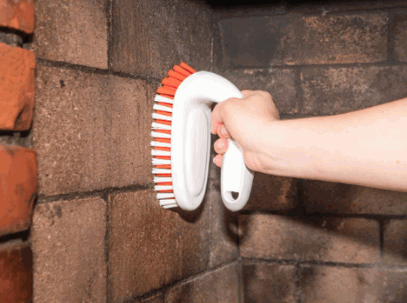
Using A Chemical Cleaner
Utilising a chemical cleaner specifically designed for soot removal can be a powerful solution for challenging stains on bricks. Many homeowners may opt for a product containing Trisodium phosphate, which is known for its effectiveness in breaking down soot and smoke residues. It is essential to follow the manufacturer’s instructions carefully and to test the cleaner in a small, inconspicuous area first to avoid potential damage to the brick.
When tackling brick cleaning, it’s paramount to consider safety precautions to protect both yourself and the environment. Ensure adequate ventilation by opening windows or using fans, and never mix different chemical products as this can create hazardous reactions. Wearing gloves and safety goggles is advisable since the chemicals can be harsh.
Here are some product recommendations, often highlighted in Readers Digest:
- Trisodium phosphate (TSP) – Excellent for heavy soot stains.
- Hydrochloric acid – Effective for deep cleaning but must be handled with care, especially near waterways to prevent contamination.
- Eco-friendly cleaners – These options are safer for both humans and pets.
In addition, always read the labels to understand the application methods and drying times, ensuring that the cleaning process follows a systematic approach for the best results.
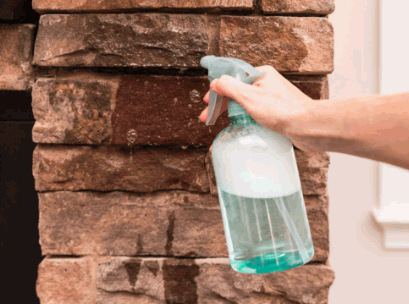
Using A Dry Cleaning Sponge
A dry cleaning sponge is a specialised tool that can be particularly effective for absorbing soot from bricks without the need for water or harsh chemicals. This technique involves gently rubbing the sponge against the soot areas, allowing the sponge’s unique structure to lift and trap soot particles. This method is ideal for delicate situations where moisture may damage the bricks, ensuring that the cleaning process is both effective and safe.
When utilising a dry cleaning sponge, it is essential to select one that suits your specific needs; different sponges come in various sizes and densities. The
- size
- type of debris
- delicacy of the surface
should be factors influencing your choice.
Before starting the cleaning process, lightly test the sponge on a small, inconspicuous area to ascertain its effectiveness without causing damage. Once you confirm its suitability, proceed with gentle strokes, applying minimal pressure to allow the sponge to absorb the soot fully. Remember to turn the sponge frequently for optimal results, ensuring that its cleaning surfaces remain effective during use.
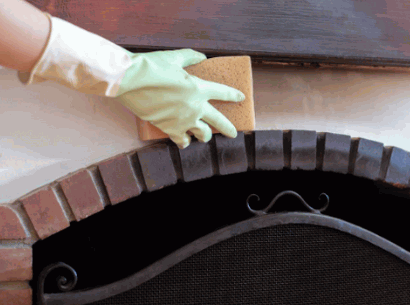
What Are The Steps For Cleaning Soot Off Bricks Using Each Method?
Cleaning soot off bricks involves distinct steps tailored to each method, ensuring optimal results and the preservation of brick integrity. Whether using a pressure washer, scrubbing brush, chemical cleaner, or dry cleaning sponge, following the specific procedures associated with each technique is essential for effective soot removal.
Understanding these steps will enable homeowners to confidently tackle soot build-up and restore the cleanliness of their fireplace areas without dropping effectiveness in the process.
Pressure Washer Method
Originating as a popular technique since 2015, this method is well-suited for large outdoor areas and has been widely adopted in regions like Colorado for its efficiency.
To clean soot off bricks using a pressure washer, begin by setting up the machine and selecting the appropriate pressure level, typically between 1200 and 2000 PSI for brick surfaces. It’s essential to choose the right setting to avoid damaging the bricks while effectively removing the soot. Next, ensure the area is clear of obstructions, and then aim the nozzle at the sooted areas at a slight angle, maintaining a distance of around 30 centimetres from the surface to avoid damage. Move the nozzle in a sweeping motion, rinsing the area thoroughly with clean water afterwards to ensure all soot particles are removed.
Following this initial step, it’s crucial to prepare the pressure washer for optimal performance:
- Check the Equipment: Before starting, inspect the pressure washer for any leaks or blockages in the hose.
- Select the Right Nozzle: Use a 25-degree nozzle tip to provide a balanced spray pattern for effective cleaning.
- Test the Pressure: Start with a lower pressure setting to gauge the surface response before adjusting to a stronger setting.
After applying the pressure washer to the bricks, spend some time observing areas that may need extra attention:
- Focus on Stubborn Spots: For particularly tough soot, consider applying a cleaning solution prior to rinsing.
- Maintain Consistent Distance: While moving the nozzle, ensure a consistent distance to prevent any uneven cleaning or potential damage.
Once finished, take a moment to inspect the area again, ensuring every bit of soot has been washed away. This thorough approach will leave your brick surfaces looking revitalised.
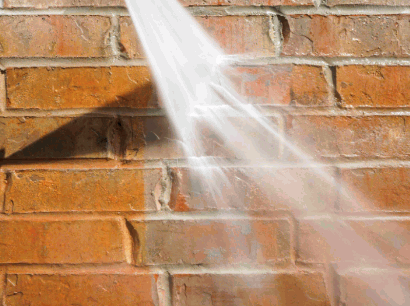
Scrub Brush And Detergent Method
To effectively clean soot off bricks using a scrubbing brush and detergent, start by mixing a solution of warm water and a mild detergent in a bucket. Dip the scrubbing brush into the solution, allowing it to soak, and begin scrubbing the sooted areas in a circular motion. Rinse the area with clean water frequently to ensure that you’re not just spreading soot around, and continue this process until the bricks are free of stains.
Once you have your solution prepared, here’s a step-by-step guide for optimal scrubbing and rinsing:
- Step 1: Ensure that any loose soot or debris is removed first by gently sweeping the area with a broom.
- Step 2: Next, dip the scrubbing brush into the soapy water and allow it to absorb the solution. This ensures a thorough cleaning.
- Step 3: Begin scrubbing from the top of the brick surface, working your way downwards. This technique prevents dirty water from dripping onto clean sections.
- Step 4: Remember to rinse the brush frequently in clean water, squeezing out excess dirt each time.
- Step 5: After scrubbing, use a clean sponge or cloth to wipe down the area once again, ensuring that all soap and soot are removed.
For best results, it’s important to use a gentle detergent to avoid damaging the bricks, and always check for any discolouration in an inconspicuous area first. Cleaning soot properly not only rejuvenates the appearance of the bricks but also extends their lifespan.

Chemical Cleaner Method
Supported by the use of powerful agents like Trisodium phosphate, this method is ideal for tackling the most stubborn soot stains.
When using a chemical cleaner to clean soot off bricks, it is vital to first read the instructions on the product label carefully. This step is crucial for safety and effectiveness. Start by applying the cleaner directly to the soot areas using a sponge or brush, and allow it to sit for the recommended time to break down the soot. Afterward, scrub the area gently and rinse thoroughly with water, ensuring all chemical residues are removed to protect the brick’s integrity.
Before initiating the cleaning process, take the necessary precautions to ensure safety:
- Wear protective gloves and safety goggles to prevent irritation.
- Ensure the area is well-ventilated to minimise inhalation of any fumes.
- Test the chemical cleaner on a small, inconspicuous section of the brick to check for adverse reactions.
After the scrubbing action, follow these rinsing techniques to maximise effectiveness:
- Use a bucket of clean water or a low-pressure hose for rinsing.
- Ensure that every nook and cranny is rinsed thoroughly to avoid chemical build-up.
This careful approach will not only enhance the appearance of your bricks but also maintain their long-term integrity and durability.

Dry Cleaning Sponge Method
To clean soot off bricks with a dry cleaning sponge, simply take the sponge and gently rub it over the sooted areas, allowing the sponge to absorb the soot particles. No additional moisture or cleaning solutions are needed, making this method ideal for more delicate surfaces. After each section, periodically cut off the soiled portion of the sponge to expose a clean area and continue until the soot is fully removed. Consider using products like Trisodium phosphate for tougher soot stains.
Using a dry cleaning sponge effectively requires a few essential steps to ensure optimal results. Here’s a detailed guideline to maximise the sponge’s cleaning capacity, as recommended by cleaning experts:
- Preparation: Before starting, ensure the area is well-ventilated to avoid inhaling any soot particles.
- Technique: Instead of pressing hard, use light, circular motions to lift the soot gently.
- Section by Section: Break down the cleaning process into manageable sections to track progress.
- Dispose of Dirt: Regularly trim the sponge; doing so maintains cleaning efficiency.
- Final Check: After completely cleaning the bricks, inspect them under good lighting to confirm no soot remains.
These techniques will help in maintaining the aesthetics of brick surfaces while ensuring effective soot removal.
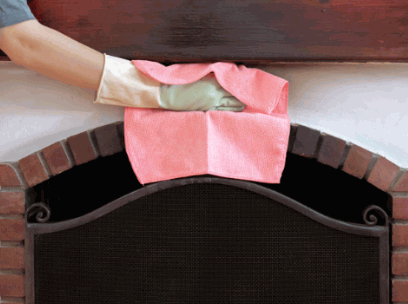
How To Maintain Clean Bricks And Prevent Soot Build-Up?
Maintaining clean bricks and preventing soot build-up requires consistent care and attention from homeowners. Regular inspections of your fireplace and chimney can help identify issues that may contribute to excessive soot deposits, while implementing good practices such as using dry and seasoned firewood, ensuring proper ventilation, and scheduling periodic professional cleanings can significantly reduce the risk of soot accumulation.
By taking these proactive measures, homeowners can preserve the cleanliness and integrity of their brick surfaces.
